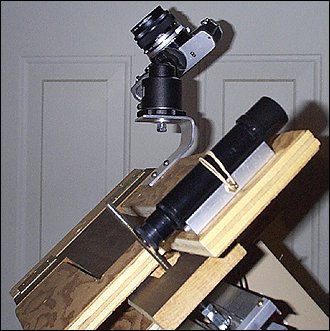 |
|
|
 |
|
|
|
Build a Barn Door Tracker
Camera Platform
The camera bracket is made from 0.125" × 2" aluminum. A commercial ball head is mounted on the bracket to hold the camera. The ball head is the single most expensive component in the project, costing $40 — more than I paid for the stepper motor and gearbox. Careful mail order shopping will save you a lot of money on the ball head; I bought mine at a local camera store.
The camera bracket can be mounted anywhere on the camera platform, although mounting it near the hinged end of the platform will provide the best stability. Also, you should select a location where the mount is least likely to interfere with your ability to look through the camera's viewfinder. I've already decided to mount at least one additional bracket on the lower part of the platform to make it easier to use the viewfinder when the camera is pointed at the northern sky.
The finder scope is used to polar align the mount. It is mounted on a piece of aluminum channel and held in place with a rubber band. The orientation of the channel was adjusted until it holds the finder precisely parallel to the mount's hinges. The photos show a 5x24 finder, but I recently switched to a 6x30 finder and a better finder bracket, which is a major improvement.
Polar Alignment
Aligning the finder with the hinges is easier said than done, but it is absolutely essential. Point the mount at any convenient star field. The region around the celestial pole makes sense, since you want the mount oriented in that direction anyway, but any star field will do. Or, you can align the finder with the hinges in the daytime, using a distant object.
While looking through the finder, swing the camera platform through its range of motion. Do the finder crosshairs remain pointed at exactly the same spot as you move the camera platform? Probably not, which tells you the finder is not parallel to the hinges. Adjust the finder slightly, and try again. Keep doing this until the crosshairs stay on the same spot as you move the camera platform. At that point, the finder is parallel to the hinges. It can easily take me 20 minutes to get it right on.
Once the finder is aligned with the hinges of the mount, you can proceed to align the mount with the celestial pole. The latitude screw on the latitude wedge is first set to its mid-range. Then the tripod legs are adjusted to make the bottom of the latitude wedge roughly level. While viewing through the finder scope, the entire tripod is then carefully moved in azimuth and the latitude screw adjusted until crosshairs in the finder are on the celestial pole.
I used SkyMap Pro to print a finder chart that matches the view in the finder scope and lets me estimate the location of the celestial pole quite accurately.
| ||||||||||||||||||||||||||||||||||||||||||||||||||||||||||||||||||||||||||||||||||||||||||||||||||||||||||||||||||||||||||||||||||||||||||||||||||||||||||||||||||||||||||||||||||||||||||||||||||||||||||||||||||||||||||||||||||
